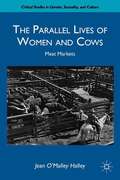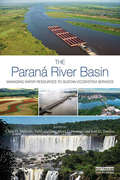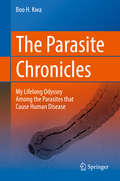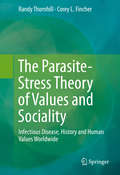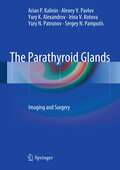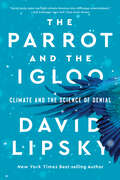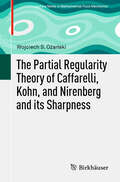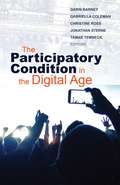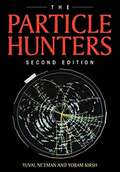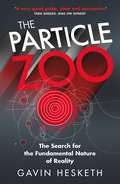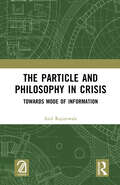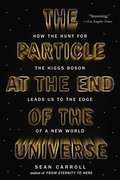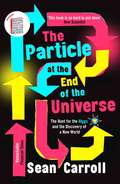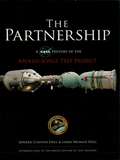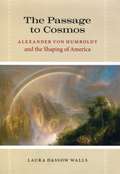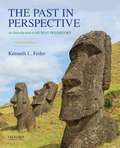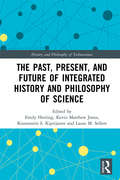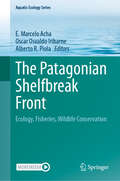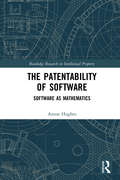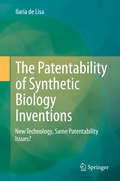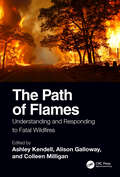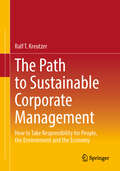- Table View
- List View
The Parallel Lives of Women and Cows: Meat Markets (Critical Studies in Gender, Sexuality, and Culture)
by Jean O’Malley HalleyWeaving together a social history of the American beef industry with her own account of growing up in the shadow of her grandfather's cattle business, Halley juxtaposes the two worlds and creates a link between the meat industry and her own experience of the formation of gender and sexuality through family violence.
The Paraná River Basin: Managing Water Resources to Sustain Ecosystem Services (Earthscan Series on Major River Basins of the World)
by Chris D. MetcalfeThis book provides insight into the hydrology, ecosystem services and management of water resources in the Paraná River basin, including the importance of water to the socio-economic development of the countries within the watershed. Running through Brazil. Paraguay and Argentina, the Paraná River and its watershed is home to some of South America's major population centers as well as important ecosystems threatened by development. At the same time, the river is a major resource driving the economies of the nations within its boundaries. This volume examines the impacts of environmental degradation, and the tradeoffs between the energy sector and the maintenance of ecosystem services. In particular, it focuses on the threats from development to sensitive ecosystems within the basin and the challenges of transboundary management of water resources. In addition to presenting wider perspectives on water management, the volume specifically covers water infrastructure, aquatic ecosystems, water quality, geomorphological influences and the impact of climate change. Finally, by assessing each country's current status in meeting the Sustainable Development Goals this volume provides a timely analysis as national governments within the basin are becoming increasingly concerned about the sustainability of the freshwater ecosystems within the Paraná River basin. This book will be of great interest to students and scholars of water and natural resource management, environmental policy, sustainable development and Latin American studies. It will also be relevant to water management professionals.
The Parasite Chronicles: My Lifelong Odyssey Among The Parasites That Cause Human Disease
by Boo H. KwaThis book introduces the reader to the fascinating world of parasites that cause human disease. It is written in a first-person style relating anecdotes and personal encounters of parasites by the author. It tells stories about exotic parasites diseases, interesting factoids about the life history of unusual parasites species, and strange ways in which humans can become infected. However this is also a serious topic, as there is increasing movement of populations and goods occurring in a globalized world, resulting in previously exotic parasites being brought into new regions of the world. This book about parasite infections will be of interest to business travelers and tourists alike, and the book discusses simple common sense ways to avoid them.
The Parasite-Stress Theory of Values and Sociality
by Randy Thornhill Corey L. FincherThis book develops and tests an ecological and evolutionary theory of the causes of human values--the core beliefs that guide people's cognition and behavior--and their variation across time and space around the world. We call this theory the parasite-stress theory of values or the parasite-stress theory of sociality. The evidence we present in our book indicates that both a wide span of human affairs and major aspects of human cultural diversity can be understood in light of variable parasite (infectious disease) stress and the range of value systems evoked by variable parasite stress. The same evidence supports the hypothesis that people have psychological adaptations that function to adopt values dependent upon local infectious-disease adversity. The authors have identified key variables, variation in infectious disease adversity and in the core values it evokes, for understanding these topics and in novel and encompassing ways. Although the human species is the focus in the book, evidence presented in the book shows that the parasite-stress theory of sociality informs other topics in ecology and evolutionary biology such as variable family organization and speciation processes and biological diversity in general in non-human animals.
The Parathyroid Glands
by Alexey V. Pavlov Arian P. Kalinin Irina V. Kotova Sergey N. Pamputis Yury K. Alexandrov Yury N. PatrunovThis book is based on the authors' extensive practical experience in the use of modern radiological methods to diagnose parathyroid diseases and the application of advanced surgical techniques. Detailed attention is devoted to the embryological background to emphasize the significance of diagnostic and surgical peculiarities. Pre- and intraoperative imaging is discussed in depth, with a special focus on localizing techniques. Ultrasound-guided minimally invasive techniques, including percutaneous laser ablation, are fully considered. This up-to-date and richly illustrated book will interest and assist specialists in ultrasound diagnostics, radiologists, endocrinologists, and surgeons.
The Parrot and the Igloo: Climate And The Science Of Denial
by David LipskyA New York Times Editors’ Choice Named a Best Book of the Year in The New Yorker, Publishers Weekly, Chicago Tribune, and EcoLit Books A USA Today Must-Read Summer Book "David Lipsky spins top-flight climate literature into cliffhanger entertainment." —Zoë Schlanger, New York Times Book Review The New York Times best-selling author explores how “anti-science” became so virulent in American life—through a history of climate denial and its consequences. In 1956, the New York Times prophesied that once global warming really kicked in, we could see parrots in the Antarctic. In 2010, when science deniers had control of the climate story, Senator James Inhofe and his family built an igloo on the Washington Mall and plunked a sign on top: AL GORE'S NEW HOME: HONK IF YOU LOVE CLIMATE CHANGE. In The Parrot and the Igloo, best-selling author David Lipsky tells the astonishing story of how we moved from one extreme (the correct one) to the other. With narrative sweep and a superb eye for character, Lipsky unfolds the dramatic narrative of the long, strange march of climate science. The story begins with a tale of three inventors—Thomas Edison, George Westinghouse, and Nikola Tesla—who made our technological world, not knowing what they had set into motion. Then there are the scientists who sounded the alarm once they identified carbon dioxide as the culprit of our warming planet. And we meet the hucksters, zealots, and crackpots who lied about that science and misled the public in ever more outrageous ways. Lipsky masterfully traces the evolution of climate denial, exposing how it grew out of early efforts to build a network of untruth about products like aspirin and cigarettes. Featuring an indelible cast of heroes and villains, mavericks and swindlers, The Parrot and the Igloo delivers a real-life tragicomedy—one that captures the extraordinary dance of science, money, and the American character.
The Partial Regularity Theory of Caffarelli, Kohn, and Nirenberg and its Sharpness (Advances in Mathematical Fluid Mechanics)
by Wojciech S. OżańskiThis monograph focuses on the partial regularity theorem, as developed by Caffarelli, Kohn, and Nirenberg (CKN), and offers a proof of the upper bound on the Hausdorff dimension of the singular set of weak solutions of the Navier-Stokes inequality, while also providing a clear and insightful presentation of Scheffer’s constructions showing their bound cannot be improved. A short, complete, and self-contained proof of CKN is presented in the second chapter, allowing the remainder of the book to be fully dedicated to a topic of central importance: the sharpness result of Scheffer. Chapters three and four contain a highly readable proof of this result, featuring new improvements as well. Researchers in mathematical fluid mechanics, as well as those working in partial differential equations more generally, will find this monograph invaluable.
The Participatory Condition in the Digital Age (Electronic Mediations #51)
by Christine Ross Jonathan Sterne Darin Barney Gabriella Coleman Tamar TembeckJust what is the &“participatory condition&”? It is the situation in which taking part in something with others has become both environmental and normative. The fact that we have always participated does not mean we have always lived under the participatory condition. What is distinctive about the present is the extent to which the everyday social, economic, cultural, and political activities that comprise simply being in the world have been thematized and organized around the priority of participation. Structured along four axes investigating the relations between participation and politics, surveillance, openness, and aesthetics, The Participatory Condition in the Digital Age comprises fifteen essays that explore the promises, possibilities, and failures of contemporary participatory media practices as related to power, Occupy Wall Street, the Arab Spring uprisings, worker-owned cooperatives for the post-Internet age; paradoxes of participation, media activism, open source projects; participatory civic life; commercial surveillance; contemporary art and design; and education. This book represents the most comprehensive and transdisciplinary endeavor to date to examine the nature, place, and value of participation in the digital age. Just as in 1979, when Jean-François Lyotard proposed that &“the postmodern condition&” was characterized by the questioning of historical grand narratives, The Participatory Condition in the Digital Age investigates how participation has become a central preoccupation of our time. Contributors: Mark Andrejevic, Pomona College; Bart Cammaerts, London School of Economics and Political Science (LSE); Nico Carpentier, Vrije Universiteit Brussel (VUB – Free University of Brussels) and Charles University in Prague; Julie E. Cohen, Georgetown University; Kate Crawford, MIT; Alessandro Delfanti, University of Toronto; Christina Dunbar-Hester, University of Southern California; Rudolf Frieling, California College of Arts and the San Francisco Art Institute; Salvatore Iaconesi, La Sapienza University of Rome and ISIA Design Florence; Jason Edward Lewis, Concordia University; Rafael Lozano-Hemmer; Graham Pullin, University of Dundee; Trebor Scholz, The New School in New York City; Cayley Sorochan, McGill University; Bernard Stiegler, Institute for Research and Innovation in Paris; Krzysztof Wodiczko, Harvard Graduate School of Design; Jillian C. York.
The Particle Hunters
by Yuval Ne'Eman Yoram KirshFrom the recent discovery of the "top quark" to the search for the Higgs particle, the frontiers of particle physics beckon the imagination. Exploring in detail the full history of particle physics, Yuval Ne'eman and Yoram Kirsh explain in an engaging, nonmathematical style the principles of modern theories such as quantum mechanics and Einstein's relativity, and they brilliantly succeed in conveying to the reader the excitement that accompanied the original discoveries. The book is spiced with amusing stories on how great discoveries were made, and Ne'eman, who took an active role in some of the historical advances in particle physics, gives his personal point of view. New to this edition are sections on the discovery of the top quark; the rise and fall of the supercollider project; the detection of the Zo particle in e+e- colliders; and the use of the width of the Zo to determine the number of "generations" of quarks and leptons. The Particle Hunters will interest anyone who wants to keep pace with the progress of human knowledge. Yuval Ne'eman discovered the basic symmetry of the subatomic particles of matter, leading him to their classification, to the prediction of new particles, and to his identification (in 1962) of a new layer in the structure of matter ("quarks"). Yoram Kirsh was awarded the Aharon Katzir Prize for popular science writing in 1975.
The Particle Zoo: The Search for the Fundamental Nature of Reality
by Gavin HeskethWhat is everything really made of? If we split matter down into smaller and infinitesimally smaller pieces, where do we arrive? At the Particle Zoo - the extraordinary subatomic world of antimatter, ghostly neutrinos, strange-flavoured quarks and time-travelling electrons, gravitons and glueballs, mindboggling eleven-dimensional strings and the elusive Higgs boson itself.Be guided around this strangest of zoos by Gavin Hesketh, experimental particle physicist at humanity's greatest experiment, the Large Hadron Collider. Concisely and with a rare clarity, he demystifies how we are uncovering the inner workings of the universe and heading towards the next scientific revolution.Why are atoms so small? How did the Higgs boson save the universe? And is there a Theory of Everything? The Particle Zoo answers these and many other profound questions, and explains the big ideas of Quantum Physics, String Theory, The Big Bang and Dark Matter... and, ultimately, what we know about the true, fundamental nature of reality.
The Particle Zoo: The Search for the Fundamental Nature of Reality
by Gavin HeskethWhat is everything really made of? If we split matter down into smaller and infinitesimally smaller pieces, where do we arrive? At the Particle Zoo - the extraordinary subatomic world of antimatter, ghostly neutrinos, strange-flavoured quarks and time-travelling electrons, gravitons and glueballs, mindboggling eleven-dimensional strings and the elusive Higgs boson itself.Be guided around this strangest of zoos by Gavin Hesketh, experimental particle physicist at humanity's greatest experiment, the Large Hadron Collider. Concisely and with a rare clarity, he demystifies how we are uncovering the inner workings of the universe and heading towards the next scientific revolution.Why are atoms so small? How did the Higgs boson save the universe? And is there a Theory of Everything? The Particle Zoo answers these and many other profound questions, and explains the big ideas of Quantum Physics, String Theory, The Big Bang and Dark Matter... and, ultimately, what we know about the true, fundamental nature of reality.
The Particle and Philosophy in Crisis: Towards Mode of Information
by Anil RajimwaleThis book is a novel study on the way revolutions in science, technology and communication impact philosophy/world outlook including Marxism, society's future, mode of production, capitalism/socialism dichotomy, world economy, and trends like postmodernism and post-industrialism. It also deals with motion of and crisis created by the new concept of 'the particle' on human thought, philosophy and worldview. We ride the unprecedented scientific and technological revolution (STR) into the 'unlighted' extra-ordinary world of quantum motions. Human thought and being are shifting to and gathering speed along the time paradigm, rendering dialectics increasingly crucial, the book opines. Electronic technology, quantum discoveries and wave/particle duality as a wonder of nature have changed forever the way we look at 'the world', which stands redefined. Grounds of philosophy move away, creating epistemological crisis as we transit to a post-classical world. We now look at whole humanity from out in the space, and our dialectics and contradictions acquire new meaning. This self-transcendence can potentially free us of existing acute contradictions. Scientific literature and sources have then been creatively used in the book to take up the concepts of matter, idea, motion, time, space and dialectics. It is therefore a bold attempt to negate the existing philosophy by creatively developing a new scientific world outlook.
The Particle at the End of the Universe: How the Hunt for the Higgs Boson Leads Us to the Edge of a New World
by Sean CarrollScientists have just announced an historic discovery on a par with the splitting of the atom: the Higgs boson, the key to understanding why mass exists has been found. In The Particle at the End of the Universe, Caltech physicist and acclaimed writer Sean Carroll takes readers behind the scenes of the Large Hadron Collider at CERN to meet the scientists and explain this landmark event. The Higgs boson is the particle that more than six thousand scientists have been looking for using the Large Hadron Collider, the world's largest and highest energy particle accelerator, which lies in a tunnel 17 miles in circumference, as deep as 575 feet beneath the Franco-Swiss border near Geneva. It took ten years to build and this search has now cost over $9 billion and required the collaboration of engineers from more than one hundred countries. What is so special about the Higgs boson? We didn't really know for sure if anything at the subatomic level had any mass at all until we found it. The fact is, while we have now essentially solved the mass puzzle, there are things we didn't predict and possibilities we haven't yet dreamed. A doorway is opening into the mind boggling, somewhat frightening world of dark matter. We only discovered the electron just over a hundred years ago and considering where that took us--from nuclear energy to quantum computing--the inventions that will result from the Higgs discovery will be world-changing. The Particle at the End of the Universe not only explains the importance of the Higgs boson but also the Large Hadron Collider project itself. Projects this big don't happen without a certain amount of conniving, dealing, and occasional skullduggery-- and Sean Carroll explores it all. This is an irresistible story (including characters now set to win the Nobel Prize among other glories) about the greatest scientific achievement of our time.
The Particle at the End of the Universe: The Hunt for the Higgs and the Discovery of a New World
by Sean CarrollWinner of the 2013 Royal Society Winton Prize for Science Books It was the universe's most elusive particle, the linchpin for everything scientists dreamed up to explain how physics works. It had to be found. But projects as big as CERN's Large Hadron Collider don't happen without incredible risks - and occasional skullduggery. In the definitive account of this landmark event, Caltech physicist and acclaimed science writer Sean Carroll reveals the insights, rivalry, and wonder that fuelled the Higgs discovery, and takes us on a riveting and irresistible ride to the very edge of physics today.
The Partnership: A NASA History of the Apollo-Soyuz Test Project (Dover Books on Astronomy)
by Paul Dickson Edward Clinton Ezell Linda Neuman EzellThe 1975 Apollo-Soyuz Test Project (ASTP) was the first joint U.S.-Soviet space flight, in which teams from the two nations met in orbit to test an international docking system and conduct both collaborative and independent studies. Although primarily a symbol of international goodwill, the mission provided useful experience for future cooperative ventures between the two nations. This authorized NASA history features many fascinating interviews with participants as well as firsthand observations of ASTP activities.Because details of the Soviet space program remained shrouded in secrecy during the ASTP, the story is told from the American perspective. No scientific background is necessary to appreciate the narrative, which focuses on the participants' working relationships rather than the technical aspects of their jobs. Starting with the early years of the Cold War competition, it traces the formation of an alliance between NASA and Soviet Academy engineers in developing a test project, training the crew, and the triumphant flight. Eighty-six pages of photographs include twelve full-color pages with images of Earth from space.
The Passage to Cosmos: Alexander Von Humboldt and the Shaping of America
by Laura Dassow WallsHumboldt espoused the idea that, while the universe of nature exists apart from human purpose, its beauty and order, the very idea of the whole it composes, are human achievements: cosmos comes into being in the dance of world and mind, subject and object, science and poetry.
The Past In Perspective: An Introduction To Human Prehistory (Seventh Edition)
by Kenneth L. FederIdeal for introduction to archaeology and world prehistory courses, The Past in Perspective: An Introduction to Human Prehistory, Seventh Edition, is an engaging and up-to-date chronological overview of human prehistory. <P><P>Kenneth L. Feder introduces students to "the big picture"--the grand sweep of human evolutionary history--presenting the human past within the context of fundamental themes of cultural evolution. Feder's unique, refreshing, and accessible narrative personalizes the past and makes it relevant to today's students. <P><P>Using a consistent chapter format--"Prelude, Chronicle, Issues and Debates, Messages from the Past, and Case Study Close-up"--Feder helps students master both what we know and what is still debated about the complex story of the human past.
The Past, Present, and Future of Integrated History and Philosophy of Science (History and Philosophy of Technoscience)
by Emily Herring Kevin Matthew Jones Konstantin S. Kiprijanov Laura M SellersIntegrated History and Philosophy of Science (iHPS) is commonly understood as the study of science from a combined historical and philosophical perspective. Yet, since its gradual formation as a research field, the question of how to suitably integrate both perspectives remains open. This volume presents cutting edge research from junior iHPS scholars, and in doing so provides a snapshot of current developments within the field, explores the connection between iHPS and other academic disciplines, and demonstrates some of the topics that are attracting the attention of scholars who will help define the future of iHPS.
The Pasteurization of France
by Bruno LatourWhat can one man accomplish, even a great man and brilliant scientist? Although every town in France has a street named for Louis Pasteur, was he alone able to stop people from spitting, persuade them to dig drains, influence them to undergo vaccination? Pasteur’s success depended upon a whole network of forces, including the public hygiene movement, the medical profession (both military physicians and private practitioners), and colonial interests. It is the operation of these forces, in combination with the talent of Pasteur, that Bruno Latour sets before us as a prime example of science in action. Latour argues that the triumph of the biologist and his methodology must be understood within the particular historical convergence of competing social forces and conflicting interests. Yet Pasteur was not the only scientist working on the relationships of microbes and disease. How was he able to galvanize the other forces to support his own research? Latour shows Pasteur’s efforts to win over the French public—the farmers, industrialists, politicians, and much of the scientific establishment. Instead of reducing science to a given social environment, Latour tries to show the simultaneous building of a society and its scientific facts. The first section of the book, which retells the story of Pasteur, is a vivid description of an approach to science whose theoretical implications go far beyond a particular case study. In the second part of the book, “Irreductions,” Latour sets out his notion of the dynamics of conflict and interaction, of the “relation of forces.” Latour’s method of analysis cuts across and through the boundaries of the established disciplines of sociology, history, and the philosophy of science, to reveal how it is possible not to make the distinction between reason and force. Instead of leading to sociological reductionism, this method leads to an unexpected irreductionism.
The Patagonian Shelfbreak Front: Ecology, Fisheries, Wildlife Conservation (Aquatic Ecology Series #13)
by E. Marcelo Acha Oscar Osvaldo Iribarne Alberto R. PiolaThis book provides a compilation of basic information on the topic of the Patagonian Shelfbreak front, but integrally reanalyzes this under modern paradigms. The book provides a synthesis of the ecosystem characteristics, encompassing physical and chemical oceanography, plankton, nekton and benthos communities, fisheries and conservation issues. It provides hypothesis to guide future research, and recommendations for policymakers and stakeholders. Fronts play key roles in marine ecosystems, and shelfbreak fronts are ubiquitous elsewhere in the world ocean, broadening the interest of our proposal. The Patagonian shelfbreak front is a hot spot of marine life, with several associated fisheries and intensive use by marine birds and mammals. This book will contribute to fill the information gap of the Southwestern Atlantic, a region where there is a growing interest in terms of conservation and management actions. Its primary audience are researchers and postgraduate students, being also relevant for conservation scientists and resource managers.
The Patentability of Software: Software as Mathematics (Routledge Research in Intellectual Property)
by Anton HughesThis book explores the question of whether software should be patented. It analyses the ways in which the courts of the US, the EU, and Australia have attempted to deal with the problems surrounding the patentability of software and describes why it is that the software patent issue should be dealt with as a patentable subject matter issue, rather than as an issue of novelty or nonobviousness. Anton Hughes demonstrates that the current approach has failed and that a fresh approach to the software patent problem is needed. The book goes on to argue against the patentability of software based on its close relationship to mathematics. Drawing on historical and philosophical accounts of mathematics in pursuit of a better understanding of its nature and focusing the debate on the conditions necessary for mathematical advancement, the author puts forward an analytical framework centred around the concept of the useful arts. This analysis both explains mathematics’, and therefore software’s, nonpatentability and offers a theory of patentable subject matter consistent with Australian, American, and European patent law.
The Patentability of Synthetic Biology Inventions: New Technology, Same Patentability Issues?
by Ilaria de LisaThis book addresses Synthetic Biology (SynBio), a new and promising biotechnology that has attracted much interest from both a scientific and a policy perspective. Yet, questions concerning the patentability of SynBio inventions have not been examined in detail so far; as a result, it remains unclear whether these inventions are patentable on the basis of current norms and case law. The book addresses this question, focusing especially on the subject matter’s eligibility and moral criteria. It provides an overview of the legislation and decisions applicable to SynBio patents and examines this new technology in view of the ongoing debate over the patentability of biotechnologies in general. The legal analysis is complemented by the practical examination of several patent applications submitted to the European and US patent offices (EPO and USPTO), and by an assessment of the patent issues that are likely to be raised by future SynBio developments.
The Path of Flames: Understanding and Responding to Fatal Wildfires
by Alison Galloway Ashley Kendell Colleen MilliganThe Path of Flames: Understanding and Responding to Fatal Wildfires is an edited volume covering the complexities of response and recovery issues relative to catastrophic wildfires. As wildfires become more frequent throughout the world—and the loss of life greater, especially among residents trapped in the path of the flames—it is essential that agencies in fire-prone areas understand the complexity of the response as it relates to finding and identifying the remains of those who perished. While covering wildfire dynamics, risks for vulnerable populations, and the emergency response to wildfires, this book focuses largely on the recovery of human remains within the context of the overall response to mass disasters resulting from wildfires. As such, search protocols, staffing needs, pre-event coordination and organization, and logistical support are addressed. The scientific basis for understanding how fire will affect human remains—as well as how the level of destruction can be interpreted—is also addressed. Recognizing the multidisciplinary nature of the field, this volume covers forensic issues relating to the recovery of remains, forensic anthropology, DNA analysis, forensic odontology, and forensic pathology. The book also includes contributions from international wildfire response professionals looking at global best practices in wildfire response and human remains recovery. Specifically, several chapters cover the lessons learned from the devasting Camp Fire of 2018 in California that led to the deaths of 85 people. The Camp Fire burned nearly 19,000 structures and was ultimately the most destructive—and deadly—in California’s history. The Path of Flames is a one-of-a-kind reference that serves as a valuable resource for professionals working in the areas of emergency services, search and rescue, law enforcement, fire service, disaster planning and response, victim recovery and identification, and mass disaster and mass fatality response.
The Path to Sustainable Corporate Management: How to Take Responsibility for People, the Environment and the Economy
by Ralf T. KreutzerThis book shows how managers at all levels of the company can master the challenges of sustainable corporate management with confidence. Concrete action plans are presented for this purpose. Climate change and the finite nature of natural resources are already taking their toll worldwide. A rethink towards ecological sustainability is not only urgently needed at a global level. The orientation of corporate strategies is also increasingly determined by the socio-political morals of customers and other stakeholders, where economic and socio-political interests must be in harmony with social and ecological challenges. Using the three-pillar model for sustainability (Triple Bottom Line) and further topics (such as supply chain law and ESG criteria), the author shows in a practical way how companies can successfully meet these major challenges in the long term. The key to success lies in a change in values towards ecological, social and economic sustainability that is defined and practiced at all levels of the company. Nicola Oudejans, Course Director Chief Digital Officer at the University for Continuing Education Krems/Danube University Krems
